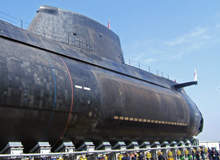
Three of the world's largest navies are placing new emphasis on undersea sonar systems in 2010. New facilities in the US and Turkey will help the navies in those nations enhance their undersea operations, while in the UK, the Royal Navy is at work on a fleet-wide upgrade and standardisation of the sonar systems on its submarines.
The US Navy says the new facility at its Naval Undersea Warfare Center (NUWC) in Newport, Rhode Island, worth an estimated $11m, will streamline and centralise its work and development on subsurface sensors. The NUWC is also moving ahead with testing of upgraded software for its AN/BQQ-10 sonar used in the American submarine fleet.
"The personnel currently working on towed arrays here at NUWC Newport have a well-deserved reputation for excellence," Dr Paul Lefebvre, technical director at the NUWC says. "I am confident that this laboratory will help us remain at the cutting edge of undersea technology."
According to the navy, the new facility will be complete in early 2011 and be known locally as the "building 1176 complex". It will serve as the navy's "only facility capable of providing development and full life-cycle support of towed arrays for both surface ships and submarines". A NUWC spokesman said the facility would be home to one-of-a-kind equipment used for the tubing and de-tubing of towed arrays; a small, environmentally compliant tank farm for storing specialised fluids used in the refurbishment of towed arrays, unique test equipment and specialised material-handling equipment.
The new facility will allow some undersea sensor work that had been performed at the Space and Naval Warfare Command facility in Virginia to be relocated to the Rhode Island base. The consolidation of all of the navy's maritime subsurface sensors functions was part of the 2005 US military's base realignment and closure commission's report.
"The BRAC commission recognised that collocating repair and overhaul work with the engineers involved with the design and acquisition of new and upgraded systems would result in synergies to improve quality and service to the navy fleet," Capt. Michael Byman, the NUWC commander says.
NUWC will have a workforce of ten civilians and about 125 contractors, the navy says, and while work has begun on that new facility, Lefebvre said that the NUWC was also proceeding to upgrade the navy's AN/BQQ-10 sonar. Last year the navy conducted a test of its acoustic rapid commercial-off-the-shelf (COTS) insertion AN/BQQ-10 sonar aboard the Los Angeles Class fast attack submarine USS Asheville. Lefebvre said new trackers based on promoted contact followers were tested during high-density contact management operations.
"The TB-34 (wideband TB-16) and reduced-length TB-29A (TB-29RL) arrays were simultaneously deployed and evaluated through the processing chain. The processing system operated reliably and we identified software improvements that will need to be made," an NUWC spokesman said. A timetable on when those improvements would be implemented throughout the fleet was not released.
The test aboard the Asheville and the start of the new construction came during a historic year for the navy at Newport, as the navy marked its 140th anniversary of undersea warfare operations in the area. The Newport naval torpedo station, which was established on Goat Island in Newport Harbour, was inaugurated on 29 July 1869.
Royal Navy upgrades and standardises SSN sonar
Defence contractor Thales UK, working with BAE Systems, will upgrade the sonar systems on six British submarines. Thales said in addition to upgrading the existing technology on the subs, the work will help to standardise the technology across the fleet, a key goal of the UK Ministry of Defence.
Under the contract, announced on 12 February 2010, Thales will install sonar 2076 stage 5 systems in three each Trafalgar Class and Astute Class SSNs, an upgrade from the stage 4 systems now on the subs.
The craft will be fitted out at the Royal Navy dockyard at Devonport. The software development for the project was undertaken at the Thales UK site at Cheadle Heath in Manchester.
Installation work on the upgrades is expected to begin later in 2010, with work complete by the end of 2011. With the completion of the work, every SSN in the Royal Navy fleet will be operating with sonar 2076 stage 5 equipment.
"The upgrade is being rolled out to the navy's SSN fleet fitted with sonar 2076 and introduces [commercial-off-the-shelf] technology for all the sonar inboard processing in an open architecture environment," Ed Lowe, managing director of Thales UK's naval business, says. "This solution will enable new operational needs and capability to be inserted into the sonar by any third party significantly more quickly than was previously possible."
A Thales spokesman said the total value of the sonar upgrade project for all parties was approximately £20m.
Turkey names "acoustic centre of excellence"
Defence contractor Meteksan Savunma was named Turkey's "acoustics centre of excellence" in late 2009. Meteksan, based in the Turkish capital of Ankara, will support the Turkish Navy's ongoing national corvette programme and develop additional projects for domestic use and international sales.
In a contract worth more than $40m, Meteksan will build and install the "wet ends" of sonar units for the navy's Milgem corvettes, the first of which, TCG Heybeliada, is undergoing sea trials now and is expected to formally enter service with the fleet in early 2011. Meteksan will also be doing sonar development and production work for four non-nuclear submarines that the Turkish Navy is purchasing from German shipbuilder Howaldtswerke Deutsche Werft AG, in a deal that was
announced in 2009.
Naming Meteksan Savunma as a centre of excellence is part of an ongoing effort by the Turkish undersecretariat for defence industries to increase domestic defence industrial output. To support its acoustics work, Meteksan announced new partnerships with two of the largest universities in Turkey in 2009 to support R&D efforts.







